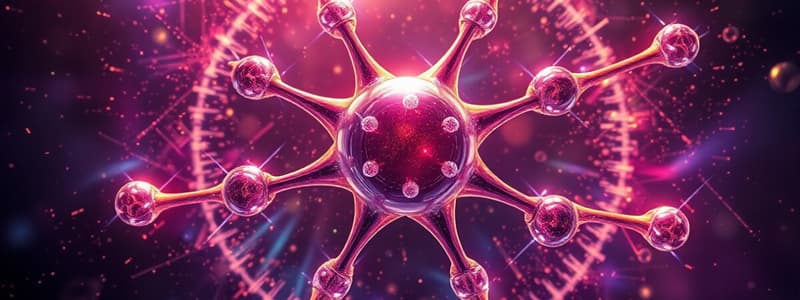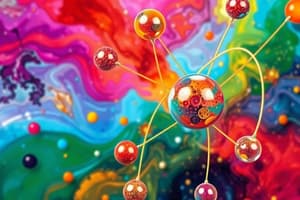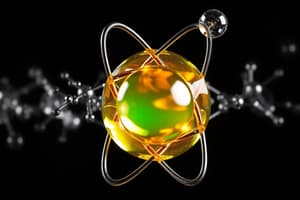Podcast
Questions and Answers
What primarily determines the efficiency of a machine?
What primarily determines the efficiency of a machine?
- The friction between moving parts (correct)
- The type of material used in construction
- The amount of work input
- The speed of operation
Which type of momentum involves a body continuing to spin about an axis?
Which type of momentum involves a body continuing to spin about an axis?
- Linear momentum
- Centripetal momentum
- Rotational momentum
- Angular momentum (correct)
What effect does lubrication have on friction?
What effect does lubrication have on friction?
- It has no impact on friction
- It reduces friction (correct)
- It eliminates all friction
- It increases friction
Which of the following statements about friction is true?
Which of the following statements about friction is true?
What is the formula for calculating efficiency?
What is the formula for calculating efficiency?
What occurs when the resultant of all forces acting on an object is zero?
What occurs when the resultant of all forces acting on an object is zero?
Which formula defines Mechanical Advantage (MA)?
Which formula defines Mechanical Advantage (MA)?
What type of lever is represented by a crowbar?
What type of lever is represented by a crowbar?
What is defined as the force acting through a section of solid material?
What is defined as the force acting through a section of solid material?
Which type of stress is caused by forces that pull something apart?
Which type of stress is caused by forces that pull something apart?
What happens if strain is less than the material's elastic limit?
What happens if strain is less than the material's elastic limit?
What is residual stress often caused by?
What is residual stress often caused by?
What do aerodynamic and gravitational forces try to do to a wing?
What do aerodynamic and gravitational forces try to do to a wing?
What is the term for negative acceleration?
What is the term for negative acceleration?
According to Newton's Second Law, how is acceleration related to force and mass?
According to Newton's Second Law, how is acceleration related to force and mass?
What describes the property of mass that resists changes in motion?
What describes the property of mass that resists changes in motion?
How does a centripetal force affect an object in circular motion?
How does a centripetal force affect an object in circular motion?
What phenomenon occurs when two objects with the same natural frequency are connected and one vibrates?
What phenomenon occurs when two objects with the same natural frequency are connected and one vibrates?
Which type of motion refers to repeated motion over time?
Which type of motion refers to repeated motion over time?
What is commonly known as the energy contained in a body moving with simple harmonic motion?
What is commonly known as the energy contained in a body moving with simple harmonic motion?
What can result from vibration in an aircraft structure over time?
What can result from vibration in an aircraft structure over time?
What type of stresses must the top and bottom surfaces of a wing withstand?
What type of stresses must the top and bottom surfaces of a wing withstand?
Which of the following statements about the pressure exerted by a column of liquid is true?
Which of the following statements about the pressure exerted by a column of liquid is true?
What property defines density?
What property defines density?
According to Archimedes' principle, what determines if an object will float?
According to Archimedes' principle, what determines if an object will float?
What does Pascal's law state about pressure in confined liquids?
What does Pascal's law state about pressure in confined liquids?
How is speed different from velocity?
How is speed different from velocity?
What characterizes liquids compared to gases?
What characterizes liquids compared to gases?
What is specific gravity?
What is specific gravity?
What defines a compound?
What defines a compound?
Which statement about ions is correct?
Which statement about ions is correct?
What occurs to a solid when heat is added to it?
What occurs to a solid when heat is added to it?
Which of the following statements regarding the states of matter is true?
Which of the following statements regarding the states of matter is true?
What is the relationship between the number of electrons in an atom's shell and its shell number?
What is the relationship between the number of electrons in an atom's shell and its shell number?
What is the primary reason that liquids are incompressible?
What is the primary reason that liquids are incompressible?
Which of the following best describes a force?
Which of the following best describes a force?
Which of the following statements is true about mixtures?
Which of the following statements is true about mixtures?
What is the relationship described by Bernoulli's principle?
What is the relationship described by Bernoulli's principle?
Which effect explains the reduction of static pressure through a constriction?
Which effect explains the reduction of static pressure through a constriction?
What contributes to the generation of lift in aircraft wings?
What contributes to the generation of lift in aircraft wings?
What does the law of conservation of energy state?
What does the law of conservation of energy state?
Which process requires physical contact for heat transfer?
Which process requires physical contact for heat transfer?
In which situation does convection primarily occur?
In which situation does convection primarily occur?
What is defined as the quantity of heat required to raise the temperature of one gram of water by one degree Celsius?
What is defined as the quantity of heat required to raise the temperature of one gram of water by one degree Celsius?
What is the SI unit for all forms of energy?
What is the SI unit for all forms of energy?
What primarily influences the dynamic pressure experienced by an aircraft during flight?
What primarily influences the dynamic pressure experienced by an aircraft during flight?
Which type of pressure is responsible for the expansion or contraction of a sealed capsule in a total pressure measurement system?
Which type of pressure is responsible for the expansion or contraction of a sealed capsule in a total pressure measurement system?
In Bernoulli's experiments, which factor does not alter the static pressure in a fluid system?
In Bernoulli's experiments, which factor does not alter the static pressure in a fluid system?
What is indicated airspeed a measure of in terms of aerodynamics?
What is indicated airspeed a measure of in terms of aerodynamics?
If the speed of an aircraft is doubled, how does the dynamic pressure change?
If the speed of an aircraft is doubled, how does the dynamic pressure change?
Which part of a fluid has the most static pressure in Bernoulli’s tube experiment?
Which part of a fluid has the most static pressure in Bernoulli’s tube experiment?
What is the significance of resistance during an aircraft's flight?
What is the significance of resistance during an aircraft's flight?
What component measures static pressure in a pressure system for an aircraft?
What component measures static pressure in a pressure system for an aircraft?
What characterizes the behavior of a liquid compared to a gas?
What characterizes the behavior of a liquid compared to a gas?
What does viscosity refer to in the context of fluid dynamics?
What does viscosity refer to in the context of fluid dynamics?
How does a gas behave in terms of volume and shape compared to a liquid?
How does a gas behave in terms of volume and shape compared to a liquid?
In terms of air viscosity, what is its primary benefit in aerodynamic contexts?
In terms of air viscosity, what is its primary benefit in aerodynamic contexts?
What is the general effect of applying a force to a rotating body like in aircraft dynamics?
What is the general effect of applying a force to a rotating body like in aircraft dynamics?
What is the viscosity index of a fluid a measure of?
What is the viscosity index of a fluid a measure of?
Which statement best describes how air behaves when it has a small amount of viscosity?
Which statement best describes how air behaves when it has a small amount of viscosity?
What happens to a liquid when a significant force is applied to it?
What happens to a liquid when a significant force is applied to it?
What happens to the viscosity of most liquids as the temperature increases?
What happens to the viscosity of most liquids as the temperature increases?
In the context of lubricating oils, why is a low viscosity index desirable?
In the context of lubricating oils, why is a low viscosity index desirable?
What is the Boundary Layer in fluid dynamics?
What is the Boundary Layer in fluid dynamics?
How does the shape of an object affect its air resistance?
How does the shape of an object affect its air resistance?
What is the Coanda Effect?
What is the Coanda Effect?
What occurs to gas viscosity when the temperature increases?
What occurs to gas viscosity when the temperature increases?
When does separated flow occur in fluid dynamics?
When does separated flow occur in fluid dynamics?
What is the primary effect of streamlining on an object's airflow?
What is the primary effect of streamlining on an object's airflow?
Flashcards
Matter
Matter
Anything that occupies space and has mass; exists as solid, liquid, or gas.
Element
Element
Simplest form of matter, made of atoms.
Atom
Atom
Basic unit of an element, made of protons, neutrons, and electrons.
Compound
Compound
Signup and view all the flashcards
Solid
Solid
Signup and view all the flashcards
Liquid
Liquid
Signup and view all the flashcards
Gas
Gas
Signup and view all the flashcards
Force
Force
Signup and view all the flashcards
What are the stresses on a wing?
What are the stresses on a wing?
Signup and view all the flashcards
What is the difference between liquids and gases?
What is the difference between liquids and gases?
Signup and view all the flashcards
What factors determine pressure in a fluid?
What factors determine pressure in a fluid?
Signup and view all the flashcards
What is density?
What is density?
Signup and view all the flashcards
Equilibrium (forces)
Equilibrium (forces)
Signup and view all the flashcards
What is specific gravity?
What is specific gravity?
Signup and view all the flashcards
What is Archimedes' principle?
What is Archimedes' principle?
Signup and view all the flashcards
Simple Machine
Simple Machine
Signup and view all the flashcards
Mechanical Advantage (MA)
Mechanical Advantage (MA)
Signup and view all the flashcards
What is buoyancy force?
What is buoyancy force?
Signup and view all the flashcards
What is Pascal's law?
What is Pascal's law?
Signup and view all the flashcards
Stress (mechanics)
Stress (mechanics)
Signup and view all the flashcards
Strain (mechanics)
Strain (mechanics)
Signup and view all the flashcards
Hooke's Law
Hooke's Law
Signup and view all the flashcards
Couple
Couple
Signup and view all the flashcards
Residual Stress
Residual Stress
Signup and view all the flashcards
Acceleration
Acceleration
Signup and view all the flashcards
Deceleration
Deceleration
Signup and view all the flashcards
Inertia
Inertia
Signup and view all the flashcards
Newton's First Law
Newton's First Law
Signup and view all the flashcards
Newton's Second Law
Newton's Second Law
Signup and view all the flashcards
Newton's Third Law
Newton's Third Law
Signup and view all the flashcards
Centripetal Force
Centripetal Force
Signup and view all the flashcards
Resonance
Resonance
Signup and view all the flashcards
Friction
Friction
Signup and view all the flashcards
Coefficient of Friction
Coefficient of Friction
Signup and view all the flashcards
Efficiency of Machines
Efficiency of Machines
Signup and view all the flashcards
Linear Momentum
Linear Momentum
Signup and view all the flashcards
Angular Momentum
Angular Momentum
Signup and view all the flashcards
Dynamic Pressure
Dynamic Pressure
Signup and view all the flashcards
Bernoulli's Principle
Bernoulli's Principle
Signup and view all the flashcards
Venturi Effect
Venturi Effect
Signup and view all the flashcards
How wings generate lift
How wings generate lift
Signup and view all the flashcards
Thermal Energy
Thermal Energy
Signup and view all the flashcards
Conduction
Conduction
Signup and view all the flashcards
Convection
Convection
Signup and view all the flashcards
Calorie (cal)
Calorie (cal)
Signup and view all the flashcards
What is viscosity?
What is viscosity?
Signup and view all the flashcards
What is viscosity index?
What is viscosity index?
Signup and view all the flashcards
What is the role of viscosity in aerodynamics?
What is the role of viscosity in aerodynamics?
Signup and view all the flashcards
What is a free surface?
What is a free surface?
Signup and view all the flashcards
Do gases have a free surface?
Do gases have a free surface?
Signup and view all the flashcards
Liquid characteristics
Liquid characteristics
Signup and view all the flashcards
Gas characteristics
Gas characteristics
Signup and view all the flashcards
Static Pressure
Static Pressure
Signup and view all the flashcards
Total Pressure
Total Pressure
Signup and view all the flashcards
What is the difference between total pressure and static pressure?
What is the difference between total pressure and static pressure?
Signup and view all the flashcards
What does Bernoulli's Principle illustrate about aircraft wings?
What does Bernoulli's Principle illustrate about aircraft wings?
Signup and view all the flashcards
How does a Pitot-Static Tube work?
How does a Pitot-Static Tube work?
Signup and view all the flashcards
Viscosity and Temperature
Viscosity and Temperature
Signup and view all the flashcards
Viscosity Index
Viscosity Index
Signup and view all the flashcards
Gas Viscosity
Gas Viscosity
Signup and view all the flashcards
Coanda Effect
Coanda Effect
Signup and view all the flashcards
Boundary Layer
Boundary Layer
Signup and view all the flashcards
Streamlining
Streamlining
Signup and view all the flashcards
Air Resistance (Drag)
Air Resistance (Drag)
Signup and view all the flashcards
Attached vs. Separated Flow
Attached vs. Separated Flow
Signup and view all the flashcards
Study Notes
Nature of Matter
- Matter occupies space and has mass, existing in solid, liquid, and gas states.
- Elements are the simplest form of matter, composed of atoms.
- Atoms are composed of protons (positive charge), neutrons (no charge), and electrons (negative charge) arranged around a dense nucleus.
- The maximum number of electrons in each shell is 2n2, where n is the shell number.
- Ions are atoms that have lost or gained electrons, becoming positively or negatively charged.
- Isotopes are atoms of the same element with different numbers of neutrons.
Chemical Compounds
- 109 known elements combine to form compounds.
- Compounds are made of identical molecules containing different atoms in fixed proportions.
- Chemical bonds form when atoms combine, often by transferring electrons.
- Mixtures are two or more substances retaining their own characteristics (e.g., salty water).
- States of matter include solids, liquids, and gases.
Topic 2: Statics
- Forces cause changes in a body's motion; start, stop, accelerate, or decelerate.
- Forces that cause no change are in equilibrium.
- Levers are simple machines that increase mechanical advantage.
- Types of levers include first-class (crowbar), second-class (wheelbarrow), and third-class (landing gear).
Elements of Stress, Strain, and Elasticity
- Stress is the force acting through a section of material, defined as force per unit area.
- Strain is the deformation of the material as a result of stress.
- Strain below the elastic limit is directly proportional to applied stress (Hooke's Law).
- Types of stress include tension (resists pulling), compression (resists crushing), shear (adjacent layers sliding), and torsion (resists twisting).
- Residual Stress occurs due to changes in temperature.
- Aircraft riveting uses compressive forces.
Pressure and Buoyancy
- Pressure in fluids is determined by vertical height, gravity, and fluid density.
- Pressure is independent of the fluid's volume or shape.
- Density is mass per unit volume of a substance.
- Specific gravity is the ratio of a substance's density to water's density.
- Archimedes' principle states buoyant force equals the weight of fluid displaced.
- If an object displaces more fluid than its weight, it floats.
Topic 2.2 Kinetics
- Atoms and molecules are constantly in motion (vibratory motion).
- The degree of motion defines the physical state (internal kinetic energy as heat).
- Liquids and gases are called fluids.
- Speed vs Velocity: speed is distance per unit time, velocity is displacement per unit time. Velocity refers to the rate at which the position changes.
- Acceleration is the rate of change in velocity (change in speed). Acceleration can be positive or negative (deceleration).
Circular Motion
- In circular motion, a force (centripetal force) must be continuously applied to maintain that circular motion.
- Inertia is the resistance of a mass to changes in motion.
- Newton's First Law states that a body will remain at rest or in uniform motion in a straight line unless acted upon by a net external force.
- Newton's Second Law states that the acceleration of an object is directly proportional to the net force acting on it and inversely proportional to its mass (F=ma).
- Newton’s Third Law states that for every action, there is an equal and opposite reaction.
Periodic Motion
- Periodic motion refers to repeated motion; examples include vibration and simple harmonic motion (SHM).
Topic 2.3 Dynamics
- Inertia is the tendency of a mass to resist changes in its state of motion.
- Newton's first law of motion describes inertia.
- Work is the product of force applied and the distance moved.
- Work is measured in joules (N*m).
- Power is work per unit time (watt).
Topic 3: Thermodynamics
- The conservation of energy states that energy cannot be created or destroyed, only transformed.
- Thermal energy is energy related to heat transfer.
Heat Transfer
- Conduction is heat transfer through physical contact.
- Convection is heat transfer by bulk movement of fluids.
- Heat transfer in a house, a kettle, or atmospheric circulation, are examples of convection.
Heat Capacity
- Heat capacity is the quantity of heat needed to raise the temperature of one unit mass by one degree.
Types of Heat (Latent vs Sensible)
- Latent heat is the heat required for a phase change (e.g., melting or boiling) without a change in temperature.
- Sensible heat is the heat that causes a tangible temperature change
Gas Laws
- Boyle's Law (constant temperature) relates pressure and volume for a gas (P1V1=P2V2 or P=k/V)
- Charles' Law (constant pressure) relates volume and temperature (V1/T1 = V2/T2 or V=kT)
- The General gas law combines Boyle's and Charles'
Thermal Energy
- Heat energy can be electrical, mechanical, chemical or nuclear.
- Heat is usually transferred from areas of high temperature to areas of low temperature.
TOPIC 4: OPTICS (LIGHT)
- Visible light (detectable by the human eye) is a form of electromagnetic radiation.
- Speed of light is approximately 3 x 108 m/s in a vacuum.
Reflection and Refraction of Light
- Reflection occurs when light waves bounce off a surface. The angle of incidence equals the angle of reflection.
- Refraction occurs when light waves bend as they pass from one medium to another. The angle of refraction depends on the density of the medium.
- Dispersion is the separation of light into its component colours due to different wavelengths being refracted by different amounts.
Studying That Suits You
Use AI to generate personalized quizzes and flashcards to suit your learning preferences.




